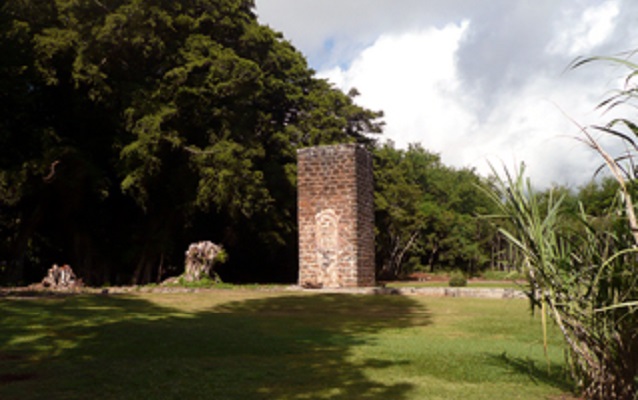Last updated: August 16, 2019
Place
Old Sugar Mill of Koloa

Photograph by Dave and Margie Hill Kleerup, Flickr
The Old Sugar Mill of Kōloa, part of the historic Ladd & Company sugar plantation, is located in the town of Kōloa, on the Island of Kauai. Sugarcane had been grown in the Hawaiian Islands for hundreds of years, and Captain Cook observed small-plot sugarcane cultivation when he first landed on Kauai in 1778. Founded in 1835, the Ladd & Company sugar plantation was the first successful large-scale sugar manufacturing enterprise in the Hawaiian Islands. Because of the fertility of the soil and the temperate climate, growing conditions were ideal for sugarcane, and sugar manufacturing soon became one of the largest industries in the islands.
In 1825, John Wilkinson, an Englishman, planted sugarcane in Manoa Valley on the Island of Hawai'i and had approximately 100 acres under cultivation at the time of his death in 1827. This is widely regarded as the first sugar plantation in the Hawaiian Islands, although it was not a commercial success. In 1833, Peter William Ladd, Allan Brinsmade, and William Hooper came to Honolulu on the Island of Oahu from the United States to establish a trading business which they named Ladd & Company. They constructed a large stone warehouse and wharf on the waterfront in Honolulu and eventually began looking for other business opportunities. In 1835, they leased 980 acres of land on the island of Kauai from the Royal Governor, Kaikioewa, specifically for the purpose of growing and processing sugar. They chose to lease in the Kōloa area because of the quality of its soil, its proximity to a good port, and its closeness to Maulili pool which had a waterfall that could be used to power a mill.
The company initially planted 12 acres of sugarcane and in 1836, produced a small amount of molasses, quickly wearing out the wooden grinding rollers at the mill. These were replaced with iron rollers which allowed for increased production and in 1837, the mill produced 4,286 pounds of sugar and 2,700 gallons of molasses, marking the first true production of sugar on a commercial scale in the Hawaiian Islands. The mill at Maulili pool was ultimately unsuccessful and a new mill was built on Waihohonu stream (present day Kōloa) in 1841. The ruins of the second mill make up the Old Sugar Mill of Kōloa National Historic Landmark.
In 1841, Ladd & Company's Kōloa sugar plantation was the site of the first general strike by native laborers in the Hawaiian Islands. The workers were paid 12.5 cents a day and went on strike to demand an increase in pay to 25 cents a day. The Kōloa plantation management refused, stating that in addition to their base pay the workers were receiving housing, fish, and land for their taro patches as well as an exemption from paying taxes to the ali'i (native chiefs). The strike was broken within two weeks. This was the first of many such strikes that affected sugar plantations in the islands throughout the 19th and 20th centuries.
Due to lack of funds, debt, and the shifting political climate in the Kingdom of Hawai'i, Ladd & Company was forced to close in 1845. The Kōloa sugar plantation and mill were repossessed by the Hawaiian government and sold to Robert Wood, William Hooper's brother-in-law, who ran the sugar operation until 1874. The old sugar mill on the Waihohonu stream was used until 1912, when it was replaced by a much larger mill located to the east of Kōloa. The Kōloa Plantation continued to operate under various owners until it closed in 1996.
Today, visitors to the site can see the remains of the Old Sugar Mill and a sculpture to the people who labored in the sugar industry in Kōloa. In addition, the towns of Koloa and Poipu host the annual Kōloa Plantation Days Celebration, a 9-day festival that celebrates both the various ethnic groups that worked on the area's sugar plantations and also the island's Native Hawaiian population.
The Old Sugar Mill of Kōloa, a National Historic Landmark, is located on the island of Kauai in Kōloa, HI at the junction of Maluhia Rd. (Highway 520) and K'loa Rd. (Highway 530) in the old town of Kōloa. The historic old town is open daily 9:00am to 9:00pm. There is no admission fee. The Old Sugar Mill of Kōloa is part of the Ka Ala Hele Waiwai Hooilina o Koloa, (Kōloa Heritage Trail), a 10-mile self-guided tour of the area's most important cultural, historical, and geological sites.
